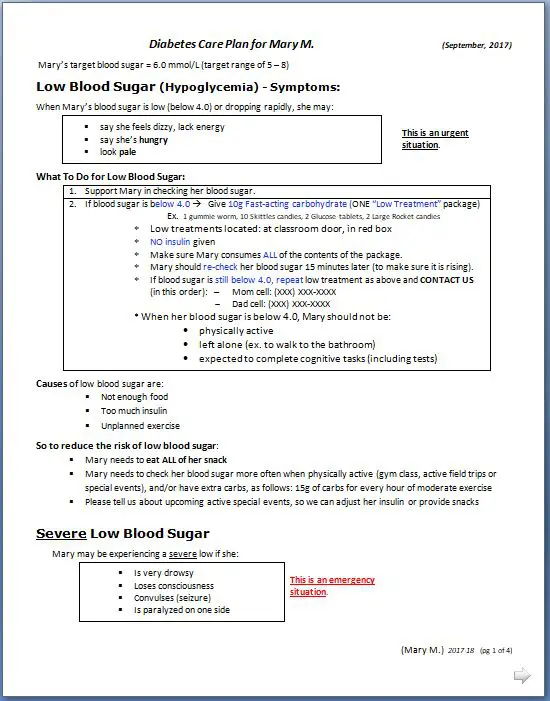Writing a Diabetes Care Plan
T1D at School: writing the support plan for a student with diabetes
A Diabetes Care Plan (which may also be called a "Support Plan," "Individual Care Plan," “Medical Care Plan,” “Student Care Plan,” or simply “Care Plan”) is a document which outlines your child’s individual needs and what specific actions are necessary to meet those needs. Anyone can write a care plan for a child with diabetes. Some schools consider this a school responsibility, and prefer to take on the task of writing a formal plan, based on information parents have provided about their child. Other schools are fine with parents providing written information that will serve as the plan. In either case, it's best if parents and school staff discuss and collaborate on its contents.
Writing a Care Plan doesn’t have to be intimidating – just ask yourself: What would I like my child’s teachers/administrators to know about how to keep her safe and help her manage her diabetes while she is at school?
What Information Should Be Included?
The specific information you contribute for your child’s Diabetes Care Plan may include (but is certainly not limited to):
- Your child’s name.
- Emergency contact information (such as parents’ and doctor’s names and phone numbers).
- A photo of your child (so other school staff not directly involved with your child can recognize her).
- Whether your child can identify her own lows.
- The specific symptoms your child typically experiences when her blood glucose is low (how does your child look, feel, act?).
- What to do when your child is low (which fast-acting carbs to provide and how much).
- Where low kits will be stored.
- Timing of snacks/meals (if required).
- Frequency, timing of blood glucose checks.
- How your child’s insulin is administered (injections, pump) and a brief description of what that looks like.
- The extent to which your child’s food intake needs to be monitored – what you would like teachers to keep an eye on (food-swapping, not completing meal, eating too much or too little) and a discussion of how this should be handled. (Is it enough for them to simply remind your child that she needs to eat? Should they ask her questions such as, “did you bolus for that”? Should they call you?)
- What to do if your child is sick at school (vomits, cannot eat, etc).
- Ketones (if applicable): what they are, who will check, when/how to check, when you want to be contacted with the results of a ketone test (ex. if blood ketones are greater than 0.6 mmol/L? If urine ketones are “small” or greater?)
- A plan for what to do before and after gym class, to prevent and treat lows, including guidelines for how much extra carbs to provide before, during or after gym class. (You could even pre-package and label a typical snack of “extra carbs” in a zip-loc, for convenience.)

The easiest way to provide the needed information is to simply fill in a ready-made Diabetes Care Plan form. A fill-in-the-blank Diabetes Student care Plan is available on the DiabetesAtSchool website (as a fillable pdf, a printable pdf to fill out by hand, or as a Microsoft Word file to fill in electronically or by hand) OR from The Alberta Children’s Hospital Diabetes Clinic.
If you prefer, you can construct your own document using as a guide the above fill-in-the-blank forms, or the Sample Care Plan document provided by WaltzingTheDragon.ca.
Some schools or school boards may have their own care plan format that they prefer to use. In that case, the information you provide will still be critical for the school to construct their care plan for your child.
Tip from the Trenches
Be concise! The information you provide for the care plan should not be more than a few pages long. If you let it, this document could quickly grow to several pages, making it less useful as a reference document.
It is also helpful to provide school staff with a concise, 1-page “cheat sheet”, or summary of the care plan, in card or poster form. For easy reference by all school staff, several copies can be made (perhaps even laminated) and taped to your child’s desk, posted in the gym or lunchroom, and/or kept in the top drawer of the teacher’s desk – anywhere a quick reference may be helpful. Click here for a Sample Summary Care Plan (Cheat Sheet).
Finally, remember that a Care Plan is a living document. It should be updated whenever there are changes to contact information, your child’s health or her medical needs. Be sure to review and update it with school staff before each new school year.
The above information was reviewed for content accuracy by clinical staff of the Alberta Children’s Hospital Diabetes Clinic.
SHARE THIS ARTICLE